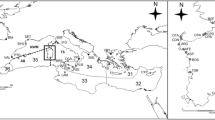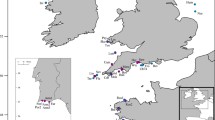Abstract
The intertidal gastropods Bembicium vittatum and Austrocochlea constricta, which have direct and planktonic larval development, respectively, occur sympatrically at sites across a number of islands at the Houtman Abrolhos archipelago and two harbours at Albany in Western Australia. Their distribution provide an opportunity to examine the effect of dispersal ability on levels of genetic subdivision at a number of spatial scales. F ST (standardised variance in allelic frequencies) values in the range 0.361 to 0.396, determined from allozyme frequencies at 12 to 13 polymorphic loci, confirm isolation of Abrolhos and Albany populations, which are separated by 900 km of coastline, in both species. Within the Abrolhos and Albany, levels of subdivision in B. vittatum were high, but similar, as indicated by F ST values of 0.091 and 0.090, respectively. In A. constricta, a mean value of 0.160 at the Abrolhos suggests severe restrictions to gene flow, while 0.021 at Albany indicates much stronger connections among populations. F ST values at the Abrolhos support previous suggestions that this archipelago favours genetic subdivision in both direct and planktonic-developing species. The Albany harbours favoured subdivision only in B. vittatum, the low values of F ST in A. constricta being attributed to strong mixing between the harbours, thus facilitating gene flow via planktonic larvae. The isolation of A. constricta populations at the Abrolhos can be explained in terms of highly localised recruitment, the result of limited water movement in complex intertidal habitats. The study illustrates the value of examining sympatric direct and planktonic developers in assessing the role of larval dispersal in patterns of genetic subdivision, and concludes that planktonic larvae may not promote gene flow over broad or even some fine spatial scales.
Similar content being viewed by others
References
Atkins RP, Iveson JB, Field RA, Parker IN (1980) A technical report on the water quality of Princess Royal Harbour, Albany. Bull Dep Conserv Envir, Perth, Australia 74: 1–67
Ayala FJ (1975) Genetic differentiation during the speciation process. Evol Biol 8: 1–78
Ayvazian SG, Johnson MS, McGlashan DJ (1994) High levels of genetic subdivision of marine and estuarine populations of the estuarine catfish Cnidoglanis macrocephalus (Plotosidae) in southwestern Australia. Mar Biol 118: 25–31
Berger EM (1973) Gene-enzyme variation in three sympatric species of Littorina. Biol Bull mar biol Lab, Woods Hole 145: 83–90
Black R, Johnson MS (1996) Tidal ponds: unusual habitats characteristic of the Houtman Abrolhos Islands. In: Wells F (ed) Proceedings of the Seventh International Marine Biological Workshop: Houtman Abrolhos Islands. Western Australian Museum, Perth (in press)
Black R, Turner SJ, Johnson MS (1994) The early life history of Bembicium vittatum Philippi, 1846. Veliger 37: 393–399
Burton PS, Feldman MW (1981) Population genetics of Tigriopus californicus. 2. Differentiation among neighbouring populations. Evolution 35: 1992–1205
Burton RS, Feldman MW (1982) Population genetics of coastal and estuarine invertebrates: does larval behaviour influence population structure? In: Kennedy VS (ed) Estuarine comparisons. Academic Press, New York, pp 537–551
Campbell CA (1978) Genetic divergence between populations of Thais lamellosa In: Battaglia B, Beardmore JA (eds) Marine organisms: genetics, ecology and evolution. Plenum Press, New York, pp 157–170
Chakraborty R, Nei M (1977) Bottleneck effects on average heterozygosity and genetic distance with the stepwise mutation model. Evolution 31: 347–356
Cresswell GR (1991) The Leeuwin Current-observations and recent models. J Proc R Soc West 74: 1–14
Cresswell GR, Golding TJ (1980) Observations of a south-flowing current in the southeastern Indian Ocean. Deep-Sea Res. 27: 449–466
Crisp DJ (1978) Genetic consequences of different reproductive strategies in marine invertebrates. In: Battaglia B, Beardmore JA (eds) Marine organisms: genetics, ecology and evolution. Plenum Press, New York, pp 257–273
Day AJ, Bayne BL (1988) Allozyme variation in populations of the dog-whelk Nucella lapillus (Prosobranchia: Muricaea) from the South West peninsula of England. Mar Biol 99: 93–100
Gooch JL, Smith BS, Knupp D (1973) Regional survey of gene frequencies in the mud snail Nassarius obsoletus. Biol Bull mar biol Lab, Woods Hole 142: 36–48
Grassle JF, Grassle JP (1978) Life histories and genetic variation in marine invertebrates. In: Battaglia B, Beardmore JA (eds) Marine organisms: genetics, ecology and evolution. Plenum Press, New York, pp 347–364
Hatcher BG (1985) Ecological research at the Houtman's Abrolhos: high latitude reefs of Western Australia, Proc 5th int coral Reef Congr 6: 291–297 [Gabrié C et al. (eds) Antenne Museum-EPHE, Moorea, French Polynesia]
Hedgecock D (1986) Is gene flow from pelagic larval dispersal important in the adaptation and evolution of marine invertebrates? Bull mar Sci 39: 550–564
Hillman K, Lukatelich RJ, Bastyan G, McComb AJ (1990) Distribution and biomass of seagrasses and algae, and nutrient pools in water, sediments and plants in Princess Royal Harbour and Oyster Harbour. Environmental Protection Authority, Perth, Western Australia (Tech Ser No. 40)
Hillman K, Lukatelich RJ, Bastyan G, McComb AJ (1991) Water quality and seagrass biomass, productivity and epiphyte load in Princess Royal Harbour, Oyster Harbour and King George Sound. Environmental Protection Authority, Perth, Western Australia (Tech Ser No. 39)
Hoagland KE (1985) Generic relationships between one British and several North American populations in Crepidula fornicata based on allozyme studies (Gastropoda: Calyptraeidae). J mollusc Stud 51: 177–182
Hodgkin EP, Clark R (1990) An inventory of information on the estuaries and coastal lagoons of South Western Australia. Estuaries of the Shire of Albany. Estuar Stud Ser envirl Protect Auth, Perth 8: 1–22
Holborn K, Johnson MS, Black R (1994) Population genetics of the corallivorous gastropod Drupella cornus at Ningaloo Reef, Western Australia. Coral Reefs 13: 33–39
Janson K (1987) Allozyme and shell variation in two marine snails (Littorina, Prosobranchia) with different dispersal abilities. Biol J Linn Soc 30: 245–256
Janson K, Ward RD (1984) Microgeographic variations in allozyme and shell characters in Littorina saxatilis Olivi (Prosobranchia: Littorinidae). Biol J Linn Soc 22: 289–307
Johnson MS (1988) Founder effects and geographic variation in the land snail Theba pisana. Heredity, Lond 61: 133–142
Johnson MS, Black R (1984a) The Wahlund effect and the geographical scale of variation in the limpet Siphonaria sp. Mar Biol 79: 295–302
Johnson MS, Black R (1984b) Pattern beneath the chaos: the effect of recruitment of genetic patchiness in an intertidal limpet. Evolution 38: 1371–1383
Johnson MS, Black R (1991) Genetic subdivision of the intertidal snail Bembicium vittatum (Gastropoda: Littorinidae) varies with habitat in the Houtman Abrolhos Islands, Western Australia. Heredity, Lond 67: 205–213
Johnson MS, Black R (1996a) Geographic cohesiveness versus associations with habitat: genetic subdivision of Bembicium vittatum Philippi (Gastropoda: Littorinidae) in the Houtman Abrolhos Islands. Biol J Linn Soc 58: 57–74
Johnson MS, Black R (1996b) Isolation and genetic subdivision of populations of gastropods in tidal ponds. In: Wells F (ed) Proceedings of the Seventh International Marine Biological Workshop: Houtman Abrolhos Islands. Western Australian Museum, Perth (in press)
Johnson MS, Creagh S, Moran M (1986a) Genetic subdivision of stocks of snapper, Chrysophrys unicolor, in Shark Bay, Western Australia. Aust J mar Freshwat Res 37: 337–345
Johnson MS, Holborn K, Black R (1993) Fine-scale patchiness and genetic heterogeneity of recruits of the corallivorous gastropod Drupella cornus. Mar Biol 117: 91–96
Johnson MS, Murray J, Clarke B (1986b) An electrophoretic analysis of phylogeny and evolutionary rates in the genus Partula from the Society Islands. Proc R Soc 227: 161–177
Johnson MS, Watts RJ, Black R (1994) High levels of genetic subdivision in peripherally isolated populations of the atherinid fish Craterocephalus capreoli in the Houtman Abrolhos Islands, Western Australia. Mar Biol 119: 179–184
Knight AJ, Hughes RN, Ward RD (1987) A striking example of the founder effect in the mollusc Littorina saxatilis. Biol J Linn Soc 32: 417–426
Knowlton N, Keller BD (1986) Larvae which fall far short of their potential: highly localised recruitment in an alpheid shrimp with extended larval development. Bull mar Sci 39: 213–223
Koehn RK, Milkman R, Mitton JB (1976) Population genetics of marine pelecypods. 4. Selection, migration and genetic differentiation in the blue mussel Mytilus edulis. Evolution 30: 2–32
Koehn RK, Mitton JB (1972) Population genetics of marine pelecypods. I. Ecological heterogeneity and evolutionary strategy at an enzyme locus. Am Nat 106: 47–56
Koehn RK, Newell RIE, Immermann F (1980) Maintenance of an aminopeptidase allele frequency cline by natural selection. Proc natn Acad Sci USA 77: 5385–5389
Lassen HH, Turano FJ (1978) Clinal variation and heterozygote deficit at the Lap-locus in Mytilus edulis. Mar Biol 49: 245–254
Mallet AL, Zouros E, Gartner-Kepkay KE, Freeman KR, Dickie LM (1985) Larval viability and heterozygote deficiency in populations of marine bivalves: evidence from pair matings of mussels. Mar Biol 165–172
Mastro E, Chow V, Hedgecock D (1982) Littorina scutulata and Littorina plena; sibling species status of two prosobranch gastropod species confirmed by electrophoresis. Veliger 24: 239–246
Mills DA, D'Adamo N (1993) Water circulation and flushing characteristics of Princess Royal Harbour. Environmental Protection Authority, Perth, Western Australia (Tech Ser No. 51)
Nei M (1978) Estimation of average heterozygosity and genetic distance from a small number of individuals. Genetics, Austin, Tex 89: 583–590
Nei M (1987) Molecular evolutionary genetics. Columbia University Press, New York
Okubo A (1971) Oceanic diffusion diagrams. Deep-Sea Res 18: 789–802
Parsons KE, Ward RD (1994) Electrophoretic and morphological examination of Austrocochlea constricta (Gastropoda: Trochidae): a species complex. Aust J mar Freshwat Res 45: 1065–1085
Reynolds J, Weir BS, Cockerham CC (1983) Estimation of the coancestry coefficient: basis for a short-term genetic distance. Genetics, Austin, Tex 105: 767–779
Rice WR (1989) Analysing tables of statistical tests. Evolution 43: 223–225
Scheltema RS (1975) Relationship of larval dispersal, gene-flow and natural selection to geographic variation of benthic invertebrates in estuaries and along coastal regions. In: Cronin LE (ed) Estuarine research. I. Chemistry, biology and the estuarine system. Academic Press, New York, pp 372–391
Scheltema RS (1979) Dispersal of pelagic larvae and the zoogeography of tertiary marine benthic gastropods. In: Gray J, Boucot AJ (eds) Historical biogeography, plate tectonics and the changing environment. Oregon State University Press, Oregon, pp 391–397
Selander RK, Smith MH, Yang SH, Johnson WE, Gentry JB (1971) Biochemical polymorphism and systematics in the genus Peromyscus. 1. Variation in the old-field mouse (Peromyscus polionotus). Stud Genet, Austin, Tex 6: 49–90
Simpson CJ, Masini RJ (eds) (1990) Albany Harbours environmental study (1988–1989). Bull envirl Protect Auth, Perth 412: 1–84
Slatkin M (1985) Gene flow in natural populations. A Rev Ecol Syst 16: 393–430
Snyder TP, Gooch JL (1973) Genetic differentiation in Littorina saxatilis (Gastopoda). Mar Biol 22: 177–182
Tatarenkov A, Johannesson K (1994) Habitat related allozyme variation on a microgeographic scale in the marine snail Littorina mariae (Prosobranchia: Littorinacea). Biol J Linn Soc 53: 105–125
Teichert C (1947) Contributions to the geology of Houtman's Abrolhos, Western Australia. Proc Linn Soc NSW 71: 145–196
Underwood AJ (1974) The reproductive cycles and geographical distribution of some common eastern Australian prosobranchs (Mollusca: Gastropoda). Aust J mar Freshwat Res 25: 63–88
Ward RD, Warwick T (1980) Genetic differentiation in the molluscan species Littorina rudis and Littorina arcana (Prosobranchia: Littorinidae). Biol J Linn Soc 14: 417–428
Watts RJ, Johnson MS, Black R (1990) Effects of recruitment on genetic patchiness in the urchin Echinometra mathaei in Western Australia. Mar Biol 105: 145–151
Weir BS, Cockerham CC (1984) Estimating F-statistics for the analysis of population structure. Evolution 38: 1358–1370
Wium-Anderson G (1970) Haemoglobin and protein variation in three species of Littorina. Ophelia 8: 267–273
Wright S (1978) Evolution and the genetics of populations. Vol. 4. Variability within and among natural populations. University of chicago Press, Chicago
Author information
Authors and Affiliations
Additional information
Communicated by G. F. Humphrey, Sydney
Rights and permissions
About this article
Cite this article
Parsons, K.E. The genetic effects of larval dispersal depend on spatial scale and habitat characteristics. Marine Biology 126, 403–414 (1996). https://doi.org/10.1007/BF00354622
Received:
Accepted:
Issue Date:
DOI: https://doi.org/10.1007/BF00354622




